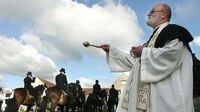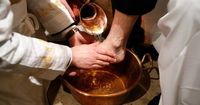Maundy Thursday, known as Gründonnerstag in German-speaking countries, is observed on the Thursday before Easter Sunday. In 2025, this significant day falls on April 17, just three days before Easter Sunday, which is celebrated on April 20. Maundy Thursday holds deep religious significance for Christians, marking the Last Supper of Jesus Christ with his twelve disciples, a pivotal event in Christian tradition.
The Last Supper, which likely occurred on either April 6, 30 AD, or April 2, 33 AD, is not only a remembrance of Jesus’ final meal but also the establishment of the Eucharist, or Holy Communion. During this meal, Jesus shared bread and wine with his disciples, declaring them as his body and blood, a ritual that continues to be central in Christian worship today. As recorded in the New Testament, he instructed his disciples, "Do this in remembrance of me," establishing a tradition that has persisted for nearly two millennia.
On Maundy Thursday, Jesus also performed the humble act of washing his disciples' feet, symbolizing mutual service and love. This act, often referred to as the "Lord's act of love," highlights the importance of serving one another, a core tenet of Christianity. The foot washing, which has been included in many church services, has evolved since 2016 to include women, reflecting a broader inclusion in this significant ritual.
As Christians around the world prepare for this solemn day, they engage in various traditions and rituals. In many churches, the Maundy Thursday service begins with a celebratory tone, often including the foot washing ceremony, and concludes in a more subdued manner as church bells fall silent until Easter Sunday. This silence signifies the transition from joy to mourning, as the community reflects on Jesus’ impending crucifixion.
In Germany, however, the observance of Maundy Thursday varies significantly by region. While it is a church holiday, it is not a public holiday in most states, with only Hesse implementing special regulations, requiring shops to close earlier at 8 PM instead of the usual midnight. Additionally, many regions impose restrictions on dance events and music performances, with bans starting as early as 6 PM in states like Baden-Württemberg and North Rhine-Westphalia.
The name "Gründonnerstag" has various interpretations. Some suggest it derives from the old German word "greinen," meaning to weep, reflecting the sorrow of penitents who were readmitted to communion on this day. Others believe it symbolizes the green of spring and the renewal of life. Historically, since the 14th century, it has been customary to prepare green vegetables or herbs on this day, a practice that continues in many households.
Despite not being a strict fasting day, it is common to serve green foods, which are seen as a symbolic gesture of spring and renewal. This tradition aligns with the broader context of Lent, which begins on Ash Wednesday and lasts for 40 days, culminating in Maundy Thursday. While Good Friday and Holy Saturday are designated fasting days, Maundy Thursday is more about reflection and preparation for the events of Easter.
The significance of Maundy Thursday extends beyond its rituals; it sets the stage for the subsequent days of Holy Week, which include Good Friday, the day of Jesus’ crucifixion, and Easter Sunday, celebrating his resurrection. Good Friday, which falls on April 18 in 2025, is observed with profound solemnity, especially among Protestant Christians, who regard it as the highest holiday of the year. On this day, services focus on the suffering and death of Jesus, with many congregations participating in the Stations of the Cross, a series of meditations on the events leading to his crucifixion.
Easter Sunday, the culmination of this holy week, is a day of joy and celebration, marking the resurrection of Jesus. The significance of this day cannot be overstated for Christians, as it represents the triumph of life over death and the core of Christian belief. The liturgical celebrations on Easter Sunday are elaborate, often beginning with the Easter Vigil on the night of Holy Saturday, featuring the lighting of the Easter candle, which symbolizes Christ as the light of the world.
The Easter candle is lit from the Paschal fire and carried into the darkened church, signifying Jesus’ resurrection. This ceremony is accompanied by readings from the Bible, including the resurrection narrative, and culminates in the Eucharist, where believers gather to celebrate the new life offered through Christ.
As the Easter period extends for fifty days until Pentecost, Christians reflect on the implications of the resurrection, which is celebrated with joy and communal gatherings. Easter Monday, occurring on April 21 in 2025, is also a public holiday in many countries, allowing families to come together and continue the celebration of Christ’s resurrection.
In conclusion, Maundy Thursday is a day rich with meaning and tradition, bridging the solemnity of Jesus’ Last Supper with the joyous celebration of Easter. It serves as a reminder of the core tenets of Christianity: love, service, and the hope of resurrection. As Christians around the world observe this day, they not only reflect on their faith but also participate in a tradition that has transcended generations, reminding them of the enduring message of hope and renewal.







